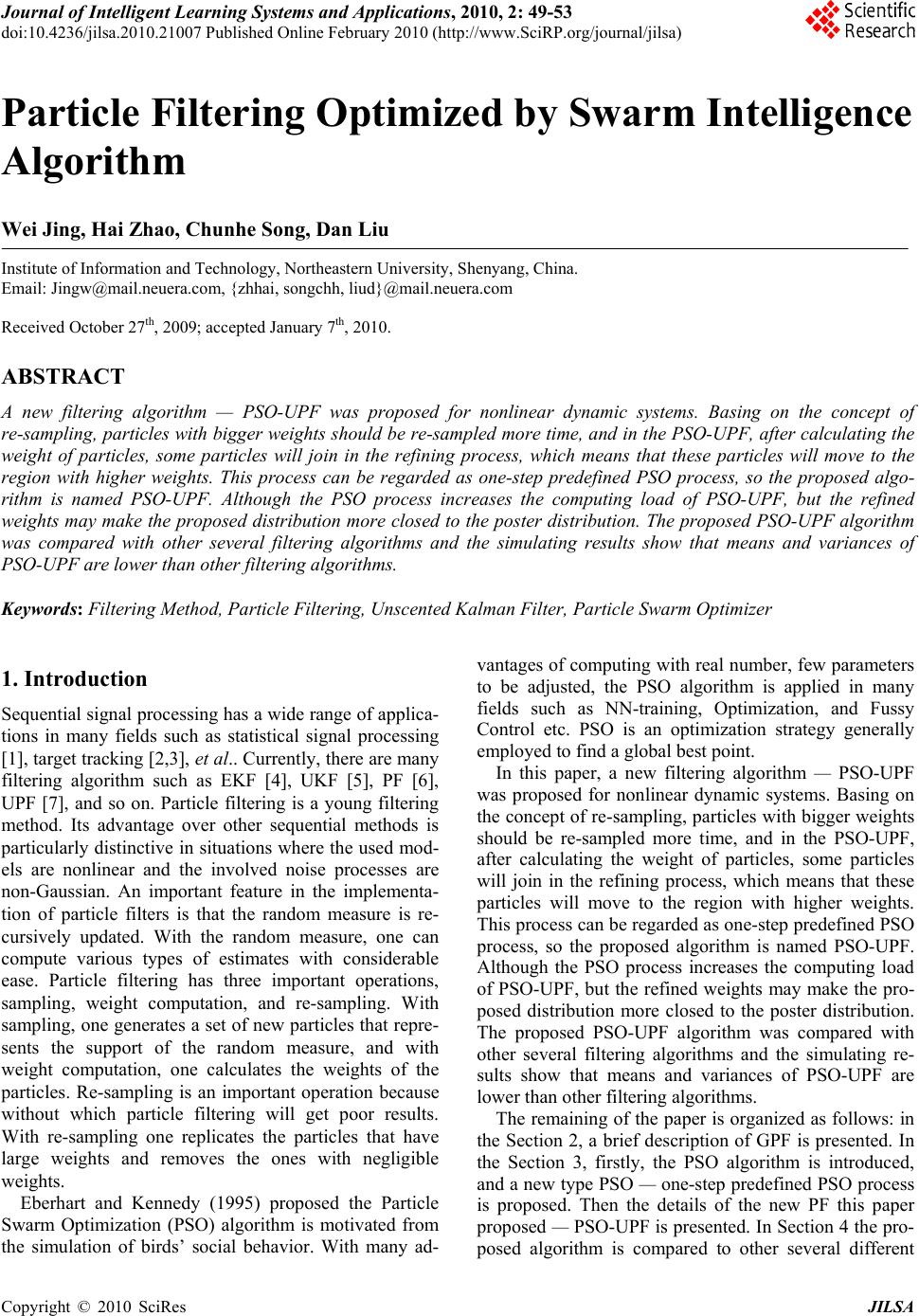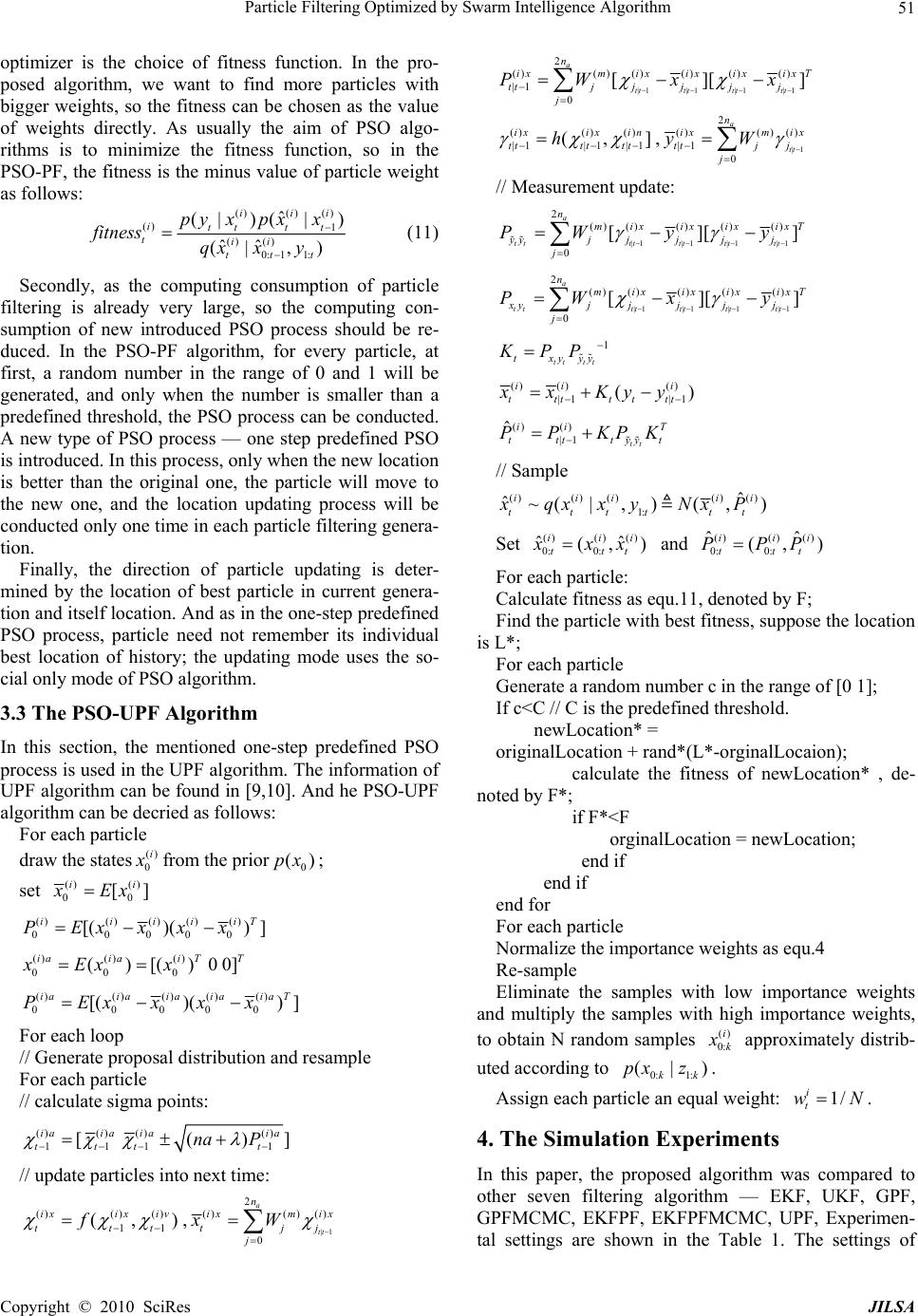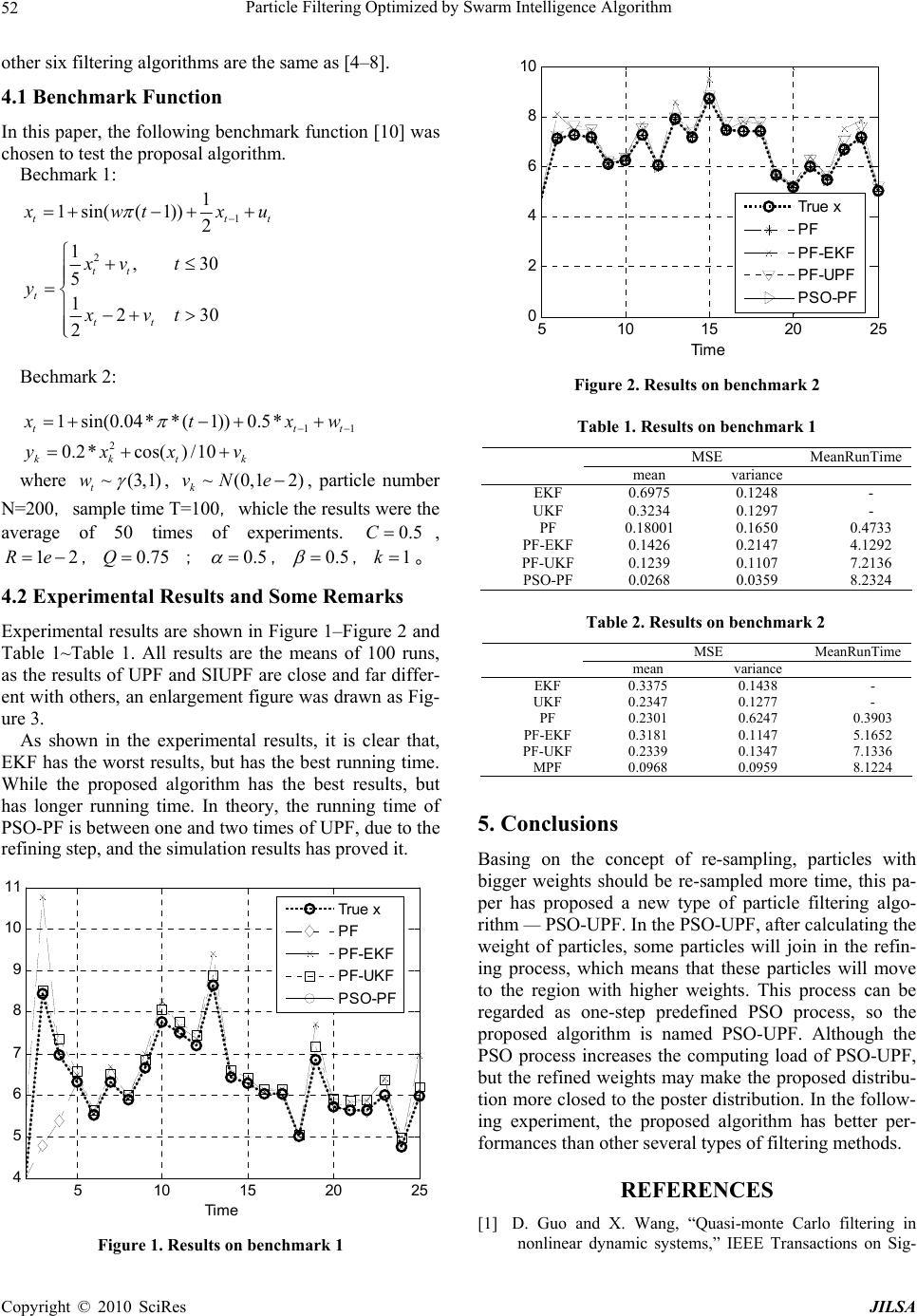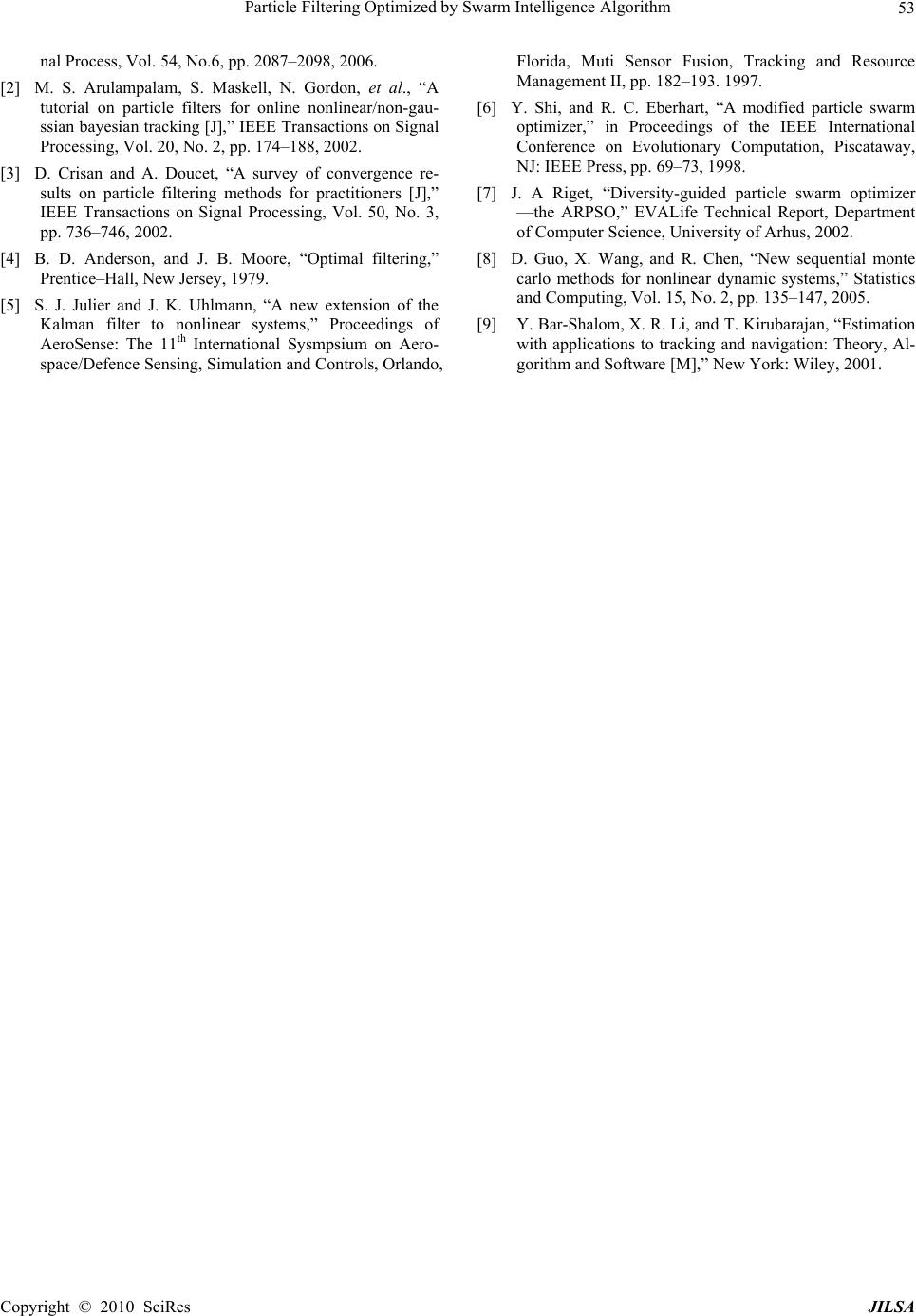Paper Menu >>
Journal Menu >>
 Journal of Intelligent Learning Systems and Applications, 2010, 2: 49-53 doi:10.4236/jilsa.2010.21007 Published Online February 2010 (http://www.SciRP.org/journal/jilsa) Copyright © 2010 SciRes JILSA Particle Filtering Optimized by Swarm Intelligence Algorithm Wei Jing, Hai Zhao, Chunhe Song, Dan Liu Institute of Information and Technology, Northeastern University, Shenyang, China. Email: Jingw@mail.neuera.com, {zhhai, songchh, liud}@mail.neuera.com Received October 27th, 2009; accepted January 7th, 2010. ABSTRACT A new filtering algorithm — PSO-UPF was proposed for nonlinear dynamic systems. Basing on the concept of re-sampling, particles with bigger weights should be re-sampled more time, and in the PSO-UPF, after calculating the weight of particles, some particles will join in the refining process, which means that these particles will move to the region with higher weights. This process can be regarded as one-step predefined PSO process, so the proposed algo- rithm is named PSO-UPF. Although the PSO process increases the computing load of PSO-UPF, but the refined weights may make the proposed distribution more closed to the poster distribution. The proposed PSO-UPF algorithm was compared with other several filtering algorithms and the simulating results show that means and variances of PSO-UPF are lower than other filtering algorithms. Keywords: Filtering Method, Particle Filtering, Unscented Kalman Filter, Particle Swarm Optimizer 1. Introduction Sequential signal processing has a wide range of applica- tions in many fields such as statistical signal processing [1], target tracking [2,3], et al.. Currently, there are many filtering algorithm such as EKF [4], UKF [5], PF [6], UPF [7], and so on. Particle filtering is a young filtering method. Its advantage over other sequential methods is particularly distinctive in situations where the used mod- els are nonlinear and the involved noise processes are non-Gaussian. An important feature in the implementa- tion of particle filters is that the random measure is re- cursively updated. With the random measure, one can compute various types of estimates with considerable ease. Particle filtering has three important operations, sampling, weight computation, and re-sampling. With sampling, one generates a set of new particles that repre- sents the support of the random measure, and with weight computation, one calculates the weights of the particles. Re-sampling is an important operation because without which particle filtering will get poor results. With re-sampling one replicates the particles that have large weights and removes the ones with negligible weights. Eberhart and Kennedy (1995) proposed the Particle Swarm Optimization (PSO) algorithm is motivated from the simulation of birds’ social behavior. With many ad- vantages of computing with real number, few parameters to be adjusted, the PSO algorithm is applied in many fields such as NN-training, Optimization, and Fussy Control etc. PSO is an optimization strategy generally employed to find a global best point. In this paper, a new filtering algorithm — PSO-UPF was proposed for nonlinear dynamic systems. Basing on the concept of re-sampling, particles with bigger weights should be re-sampled more time, and in the PSO-UPF, after calculating the weight of particles, some particles will join in the refining process, which means that these particles will move to the region with higher weights. This process can be regarded as one-step predefined PSO process, so the proposed algorithm is named PSO-UPF. Although the PSO process increases the computing load of PSO-UPF, but the refined weights may make the pro- posed distribution more closed to the poster distribution. The proposed PSO-UPF algorithm was compared with other several filtering algorithms and the simulating re- sults show that means and variances of PSO-UPF are lower than other filtering algorithms. The remaining of the paper is organized as follows: in the Section 2, a brief description of GPF is presented. In the Section 3, firstly, the PSO algorithm is introduced, and a new type PSO — one-step predefined PSO process is proposed. Then the details of the new PF this paper proposed — PSO-UPF is presented. In Section 4 the pro- posed algorithm is compared to other several different  Particle Filtering Optimized by Swarm Intelligence Algorithm 50 filtering algorithms, and finally, some concluding re- marks is given in Section 5. 2. Basic Particle Filter The problem being addressed here is an estimating prob- lem of the state of a system as a set of observations be- comes available on-line, which can be expressed as fol- lows: 1 () (,) tt ttt 1t t x fx w yhux v x n (1) where ,,, are the state of the system, the output observations, the input observa- tions, the process noise and the measurement noise. The mappings: x n t x y n t y u n t u v n t v :* xx nn f and represent the deterministic process and measurement models. :* y xv n nn h In the bayes filtering paradigm, the posterior distribu- tion is updated recursively over the current state t x given all observations up to and including time as follows [6]: 1 {} t tii Zz t 111 (| )(|)(| ) ttttt tk1 p xYpxxpxY dx (2) 1 1 (|)(|) (|) (| ) tt tt tt tt p yxpxY px Ypy Y (3) 1 1 (|)(|) (|) (| ) tt tt tt tt p yxpxY px Ypy Y (4) Using Monte Carlo sampling points, particle filter exe- cutes the filtering process by generating weighted sam- pling points of state variances recursively. Generic parti- cle filter algorithm can be predicted as follows [6]: Initialization For each particle draw the states() 0 i x from the prior; 0 ()px End For each loop importance sampling step For each particle sample ()() 00:1 ˆ~( |,) ii tt t 1: x qx xy End For each particle evaluate the importance weights up to a normalizing constant: ()() () () ()1 1() () 0: 11: ˆ (| )( |) ˆˆ (| ,) iii ii ttt t tt ii ttt py xpxx ww qx xy (5) For each particle, normalize the importance weights: ()()( )1 1 1 [ N ii j tt t j ww w // Re-sample Eliminate the samples with low importance weights and multiply the samples with high importance weights, to obtain N random samples () 0: i k x approximately distrib- uted according to . 0: 1: (| kk pxz ) Assign each particle an equal weight: . 1/ i t wN When executing particle filtering, the choice of the proposal distribution is very important. Usually, the tran- sition prior distribution is chosen to be the proposal dis- tribution: 1 (|,) (| ) ttt tk qxXYpx x 1 (7) But as not considering the recent observation, when using the transition prior distribution as the proposal dis- tribution, the filtering result is usually poor, especially when the noise is heavy. In this paper, a kind of semi-iterative unscented transformation was proposed to address this issue. 3. The PSO-UPF Algorithm 3.1 Particle Swarm Optimizer Algorithm PSO is an optimization strategy generally employed to find a global best point. At each time step, a particle up- dates its position and velocity by the following equa- tions: 11 22 (1)* ()()(()()) ()( ()()) ijijj ijij jgj ij vtwvt crtptxt crtptx t (8) (1)() (1) ijij ij xtxt vt (9) maxmax min max () g t t wwww (10) where {1, 2,...,}jDn ,{1, 2,...,}in ,n is the size of the population andis the Dimension of the space searched; is the inertia weight, generally updated as equation 3 [10], and is the maximal evolution gen- erations. and are two positive constants; and are two random values into the range Dn w g 1 c2 c max 1 r 2 r 0, 1. 3.2 PSO in the PF Process As depicted in the Section 2, in the re-sampling process of regular particle filtering, the particles with bigger weights will have more offspring, while the particles with smaller weights will have few or even on offspring. It inspires us to find more particles with big weights and reduce the number of particles with small weights, which will make the proposal distribution more closed to the poster distribution. And it is the aim of using particles swarm optimization in the particles filtering process. ] (6) The most important issue of using particles swarm Copyright © 2010 SciRes JILSA  Particle Filtering Optimized by Swarm Intelligence Algorithm51 optimizer is the choice of fitness function. In the pro- posed algorithm, we want to find more particles with bigger weights, so the fitness can be chosen as the value of weights directly. As usually the aim of PSO algo- rithms is to minimize the fitness function, so in the PSO-PF, the fitness is the minus value of particle weight as follows: ()() () () 1 () () 0: 11: ˆ (| )( |) ˆˆ (| ,) iii ittt t tii ttt py xpxx fitness qxxy (11) Secondly, as the computing consumption of particle filtering is already very large, so the computing con- sumption of new introduced PSO process should be re- duced. In the PSO-PF algorithm, for every particle, at first, a random number in the range of 0 and 1 will be generated, and only when the number is smaller than a predefined threshold, the PSO process can be conducted. A new type of PSO process — one step predefined PSO is introduced. In this process, only when the new location is better than the original one, the particle will move to the new one, and the location updating process will be conducted only one time in each particle filtering genera- tion. Finally, the direction of particle updating is deter- mined by the location of best particle in current genera- tion and itself location. And as in the one-step predefined PSO process, particle need not remember its individual best location of history; the updating mode uses the so- cial only mode of PSO algorithm. 3.3 The PSO-UPF Algorithm In this section, the mentioned one-step predefined PSO process is used in the UPF algorithm. The information of UPF algorithm can be found in [9,10]. And he PSO-UPF algorithm can be decried as follows: For each particle draw the states() 0 i x from the prior; 0 ()px set () () 00 [] ii x Ex ()()() ()() 00000 [( )()] iiiii P Exxxx T ()() () 000 ()[()00] iaiai TT xExx ()()() ()() 00000 [()() ] iaiaiaiaiaT PExxxx For each loop // Generate proposal distribution and resample For each particle // calculate sigma points: ()() ()() 111 1 [() iaiaiaia ttt t na P ] // update particles into next time: ()() () 11 (, ixix iv ttt f ),|1 2 ()( )() 0 a tt n ixm ix tj j xW |1 |1 |1 |1 2 ()()() ()() () |1 0 [][] a tt tt tt tt n ix mixixixix ttjjjjj j PW xx T ()() () |1|1 |1 (, ixix in tttttt h ] ,|1 2 ()( )() |1 0 a tt n ixm ix ttjj j yW // Measurement update: |1 |1|1 |1 2 ()() ()() () 0 [][] a tttt tttt tt n mixixixix yyjj jj j j PW yy T |1|1 |1|1 2 ( )()()()() 0 [][ a t ttttttttt n mix ixix ixT xyj jjjj j PW xy ] 1 tt tt txyyy KPP () ()() |1 |1 () ii i ttttttt xx Kyy () () |1 ˆ tt ii ttttyy PP KPK T t // Sample ()()()() () 1: ˆ ˆ~(|, )(,) iiii tttttt i x qxx yNx P Set ()() () 0: 0: ˆ (,) iii ttt ˆ x xx and ()() () 0: 0: ˆˆ (, ii ttt PPP) i For each particle: Calculate fitness as equ.11, denoted by F; Find the particle with best fitness, suppose the location is L*; For each particle Generate a random number c in the range of [0 1]; If c<C // C is the predefined threshold. newLocation* = originalLocation + rand*(L*-orginalLocaion); calculate the fitness of newLocation* , de- noted by F*; if F*<F orginalLocation = newLocation; end if end if end for For each particle Normalize the importance weights as equ.4 Re-sample Eliminate the samples with low importance weights and multiply the samples with high importance weights, to obtain N random samples () 0: i k x approximately distrib- uted according to . 0: 1: (| kk pxz ) Assign each particle an equal weight: . 1/ i t wN 4. The Simulation Experiments In this paper, the proposed algorithm was compared to other seven filtering algorithm — EKF, UKF, GPF, GPFMCMC, EKFPF, EKFPFMCMC, UPF, Experimen- tal settings are shown in the Table 1. The settings of j Copyright © 2010 SciRes JILSA  Particle Filtering Optimized by Swarm Intelligence Algorithm 52 other six filtering algorithms are the same as [4–8]. 4.1 Benchmark Function In this paper, the following benchmark function [10] was chosen to test the proposal algorithm. Bechmark 1: 1 2 1 1sin((1)) 2 1,30 5 1230 2 tt tt t tt t x wtx u xv t y xvt Bechmark 2: 11 1 sin(0.04**(1))0.5* ttt x txw 2 0.2*cos()/10 kkt yxx k v where ~(3,1) t w , , particle number N=200,sample time T=100,whicle the results were the average of 50 times of experiments. ~(0,1 2) k vNe 0.5C , , ; 1Re20.75Q0.5 ,0.5 ,1k 。 4.2 Experimental Results and Some Remarks Experimental results are shown in Figure 1–Figure 2 and Table 1~Table 1. All results are the means of 100 runs, as the results of UPF and SIUPF are close and far differ- ent with others, an enlargement figure was drawn as Fig- ure 3. As shown in the experimental results, it is clear that, EKF has the worst results, but has the best running time. While the proposed algorithm has the best results, but has longer running time. In theory, the running time of PSO-PF is between one and two times of UPF, due to the refining step, and the simulation results has proved it. 510 15 20 25 4 5 6 7 8 9 10 11 Time True x PF PF-EKF PF-UKF PSO-PF Figure 1. Results on benchmark 1 510 1520 25 0 2 4 6 8 10 Time True x PF PF-EKF PF-UPF PSO-PF Figure 2. Results on benchmark 2 Table 1. Results on benchmark 1 MSE MeanRunTime mean variance EKF 0.69750.1248 - UKF 0.3234 0.1297 - PF 0.180010.1650 0.4733 PF-EKF0.14260.2147 4.1292 PF-UKF0.12390.1107 7.2136 PSO-PF0.02680.0359 8.2324 Table 2. Results on benchmark 2 MSE MeanRunTime mean variance EKF 0.3375 0.1438 - UKF 0.2347 0.1277 - PF 0.2301 0.6247 0.3903 PF-EKF0.3181 0.1147 5.1652 PF-UKF0.2339 0.1347 7.1336 MPF 0.0968 0.0959 8.1224 5. Conclusions Basing on the concept of re-sampling, particles with bigger weights should be re-sampled more time, this pa- per has proposed a new type of particle filtering algo- rithm — PSO-UPF. In the PSO-UPF, after calculating the weight of particles, some particles will join in the refin- ing process, which means that these particles will move to the region with higher weights. This process can be regarded as one-step predefined PSO process, so the proposed algorithm is named PSO-UPF. Although the PSO process increases the computing load of PSO-UPF, but the refined weights may make the proposed distribu- tion more closed to the poster distribution. In the follow- ing experiment, the proposed algorithm has better per- formances than other several types of filtering methods. REFERENCES [1] D. Guo and X. Wang, “Quasi-monte Carlo filtering in nonlinear dynamic systems,” IEEE Transactions on Sig- Copyright © 2010 SciRes JILSA  Particle Filtering Optimized by Swarm Intelligence Algorithm Copyright © 2010 SciRes JILSA 53 nal Process, Vol. 54, No.6, pp. 2087–2098, 2006. [2] M. S. Arulampalam, S. Maskell, N. Gordon, et al., “A tutorial on particle filters for online nonlinear/non-gau- ssian bayesian tracking [J],” IEEE Transactions on Signal Processing, Vol. 20, No. 2, pp. 174–188, 2002. [3] D. Crisan and A. Doucet, “A survey of convergence re- sults on particle filtering methods for practitioners [J],” IEEE Transactions on Signal Processing, Vol. 50, No. 3, pp. 736–746, 2002. [4] B. D. Anderson, and J. B. Moore, “Optimal filtering,” Prentice–Hall, New Jersey, 1979. [5] S. J. Julier and J. K. Uhlmann, “A new extension of the Kalman filter to nonlinear systems,” Proceedings of AeroSense: The 11th International Sysmpsium on Aero- space/Defence Sensing, Simulation and Controls, Orlando, Florida, Muti Sensor Fusion, Tracking and Resource Management II, pp. 182–193. 1997. [6] Y. Shi, and R. C. Eberhart, “A modified particle swarm optimizer,” in Proceedings of the IEEE International Conference on Evolutionary Computation, Piscataway, NJ: IEEE Press, pp. 69–73, 1998. [7] J. A Riget, “Diversity-guided particle swarm optimizer —the ARPSO,” EVALife Technical Report, Department of Computer Science, University of Arhus, 2002. [8] D. Guo, X. Wang, and R. Chen, “New sequential monte carlo methods for nonlinear dynamic systems,” Statistics and Computing, Vol. 15, No. 2, pp. 135–147, 2005. [9] Y. Bar-Shalom, X. R. Li, and T. Kirubarajan, “Estimation with applications to tracking and navigation: Theory, Al- gorithm and Software [M],” New York: Wiley, 2001. |

